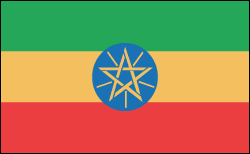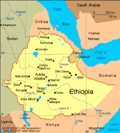Ethiopia | Facts & Information

- Ethiopia Profile
- History
- News and Current Events
Infoplease has everything you need to know about Ethiopia. Check out our country profile, full of essential information about Ethiopia's geography, history, government, economy, population, culture, religion and languages. If that's not enough, click over to our collection of world maps and flags.
Facts & Figures
-
President: Sahle-Work Zewde (2018)
Prime Minister: Abiy Ahmed Ali (2018)
Land area: 423,388 sq mi (1,096,570 sq km); total area: 426,372 sq mi (1,104,300 sq km); water area: 2,984 sq mi (7,730 sq km)
Population (2022 est.): 113,656,596 (growth rate: 2.46%); birth rate: 30.49/1000; infant mortality rate: 33.51/1000; life expectancy: 68.25
Capital and largest city (2022 est.): Addis Ababa, 5.228 million
Monetary unit: Birr
National name: Ityop'iya Federalawi Demokrasiyawi Ripeblik
Languages: Oromo (official working language in the State of Oromiya) 33.8%, Amharic (official national language) 29.3%, Somali (official working language of the State of Sumale) 6.2%, Tigrigna (Tigrinya) (official working language of the State of Tigray) 5.9%, Sidamo 4%, Wolaytta 2.2%, Gurage 2%, Afar (official working language of the State of Afar) 1.7%, Hadiyya 1.7%, Gamo 1.5%, Gedeo 1.3%, Opuuo 1.2%, Kafa 1.1%, other 8.1%, English (major foreign language taught in schools), Arabic (2007 est.)
Ethnicity/race: Oromo 35.8%, Amhara 24.1%, Somali 7.2%, Tigray 5.7%, Sidama 4.1%, Guragie 2.6%, Welaita 2.3%, Afar 2.2%, Silte 1.3%, Kefficho 1.2%, other 13.5% (2022 est.)
National Holiday: Independence Day, May 28
Ethiopian Orthodox 43.8%, Muslim 31.3%, Protestant 22.8%, Catholic 0.7%, traditional 0.6%, other 0.8% (2016 est.)
Literacy rate: 51.8% (2017 est.)
Economic summary: GDP/PPP (2020 est.): $264.05 billion; per capita $2,300. Real growth rate: 10.9%. Inflation: 15.7%. Unemployment: 3.5% (2013). Arable land: 15.2%. Agriculture: cereals, pulses, coffee, oilseed, cotton, sugarcane, potatoes, qat, cut flowers; hides, cattle, sheep, goats; fish. Labor force: 52.82 million (2017); agriculture and animal husbandry 72.7%, government and services 19.9%, industry and construction 7.4% (2013). Industries: food processing, beverages, textiles, leather, chemicals, metals processing, cement. Natural resources: small reserves of gold, platinum, copper, potash, natural gas, hydropower. Exports: $7.62 billion (2018 est.): coffee, qat, gold, leather products, live animals, oilseeds. Major trading partners (exports): China 17%, United States 16%, United Arab Emirates 8%, Saudi Arabia 6%, South Korea 5%, Germany 5% (2019). Imports: $19.93 billion (2018 est.): food and live animals, petroleum and petroleum products, chemicals, machinery, motor vehicles, cereals, textiles. Major trading partners (imports): China 27%, India 9%, United Arab Emirates 9%, France 9%, United Kingdom 7% (2019).
Communications: Telephones: main lines in use: 1.252 million (2020); mobile cellular: 44.5 million (2020). Broadcast media: 6 public TV stations broadcasting nationally and 10 public radio broadcasters; 7 private radio stations and 19 community radio stations (2017). Internet hosts: 179 (2012). Internet users: 27,591,260 (2020).
Transportation: Railways: total: 659 km (2017) (Ethiopian segment of the 756 km Addis Ababa-Djibouti railroad). Highways: total: 120,171 km (2018). Ports and harbors: Ethiopia is landlocked and uses the ports of Djibouti in Djibouti and Berbera in Somalia. Airports: 57 (2021)
International disputes: Eritrea and Ethiopia agreed to abide by the 2002 Eritrea-Ethiopia Boundary Commission's (EEBC) delimitation decision, but neither party responded to the revised line detailed in the November 2006 EEBC Demarcation Statement; the undemarcated former British administrative line has little meaning as a political separation to rival clans within Ethiopia's Ogaden and southern Somalia's Oromo region; Ethiopian forces invaded southern Somalia and routed Islamist Courts from Mogadishu in January 2007; "Somaliland" secessionists provide port facilities in Berbera and trade ties to landlocked Ethiopia; civil unrest in eastern Sudan has hampered efforts to demarcate the porous boundary with Ethiopia.









